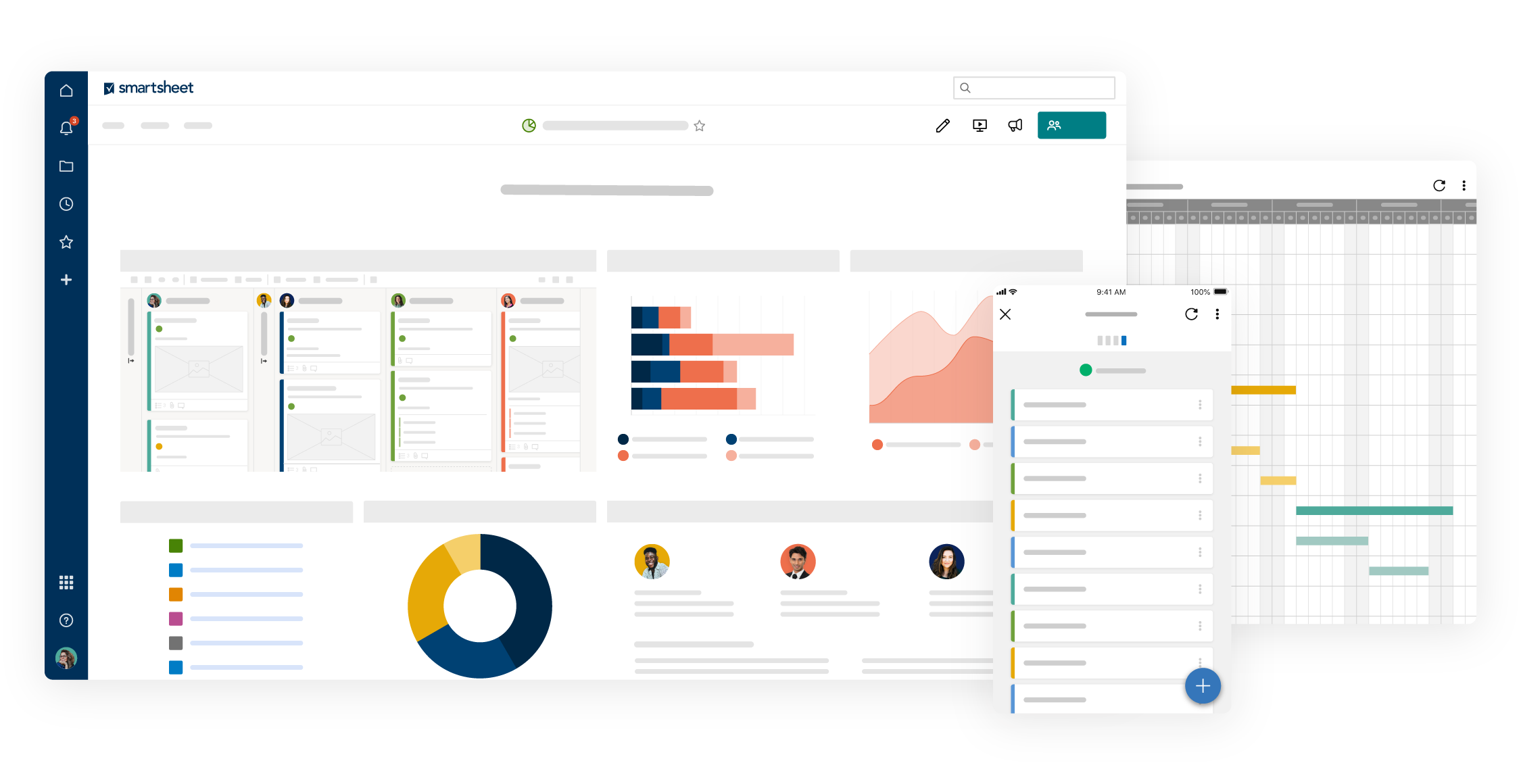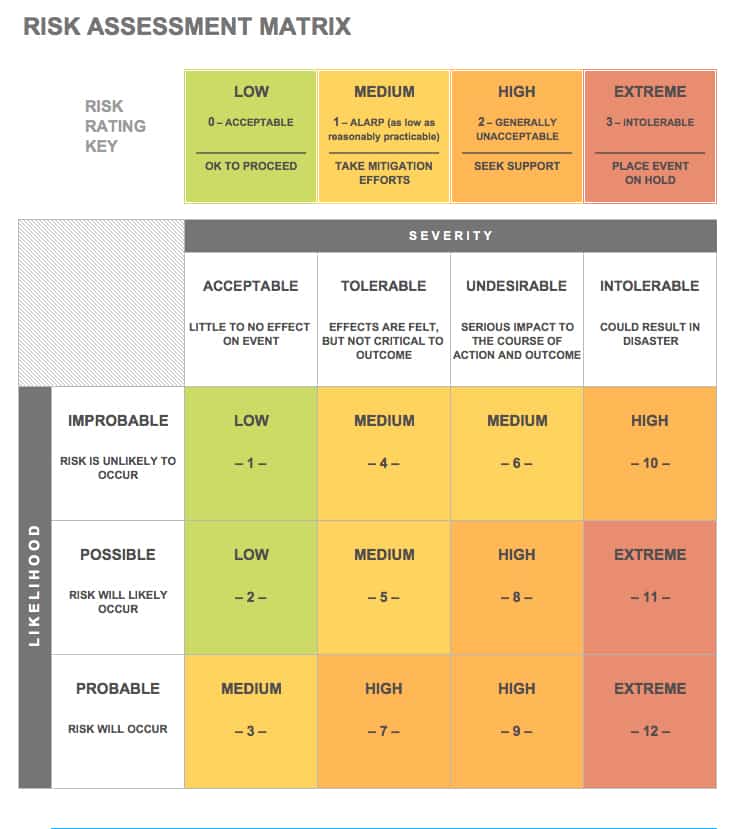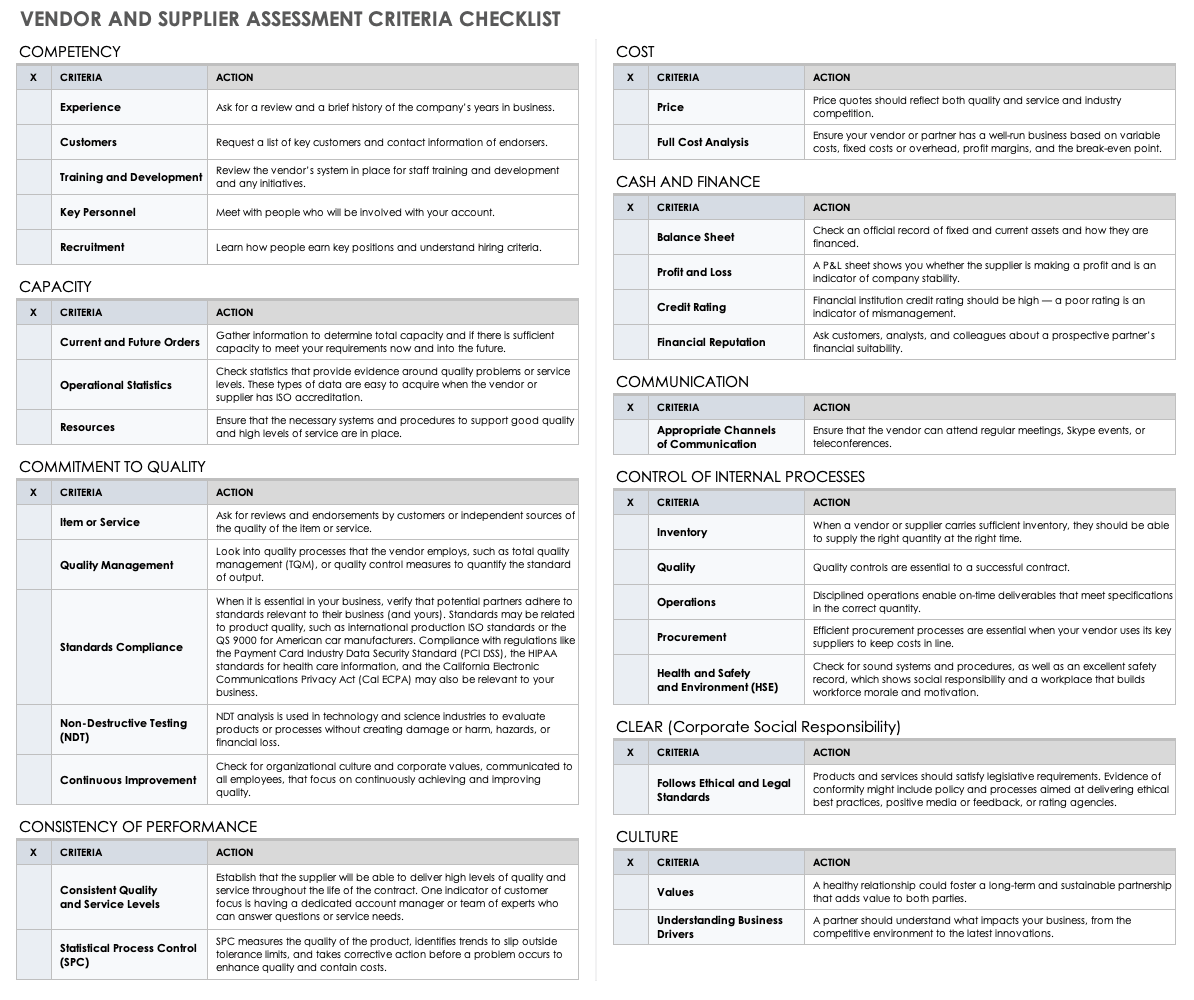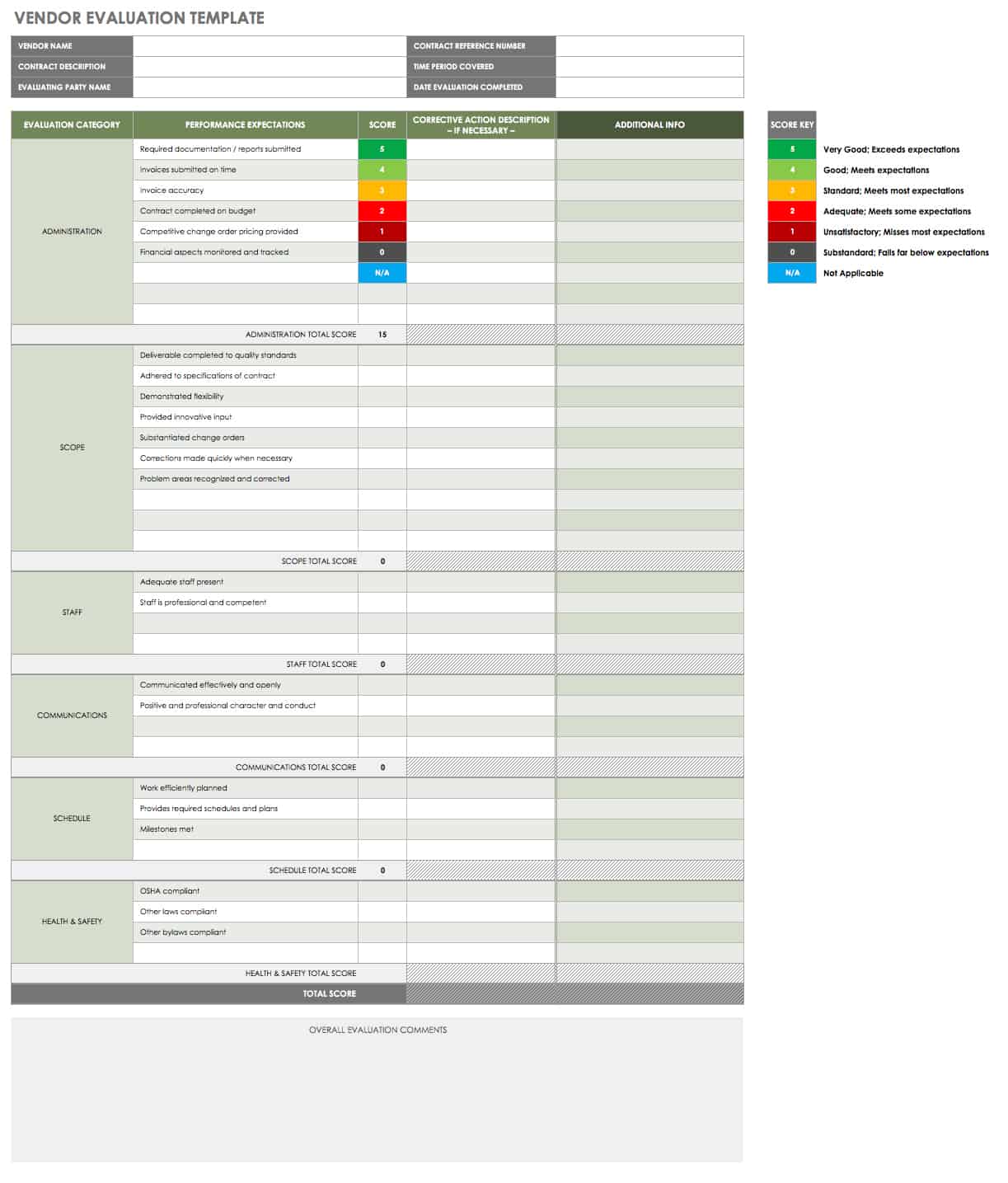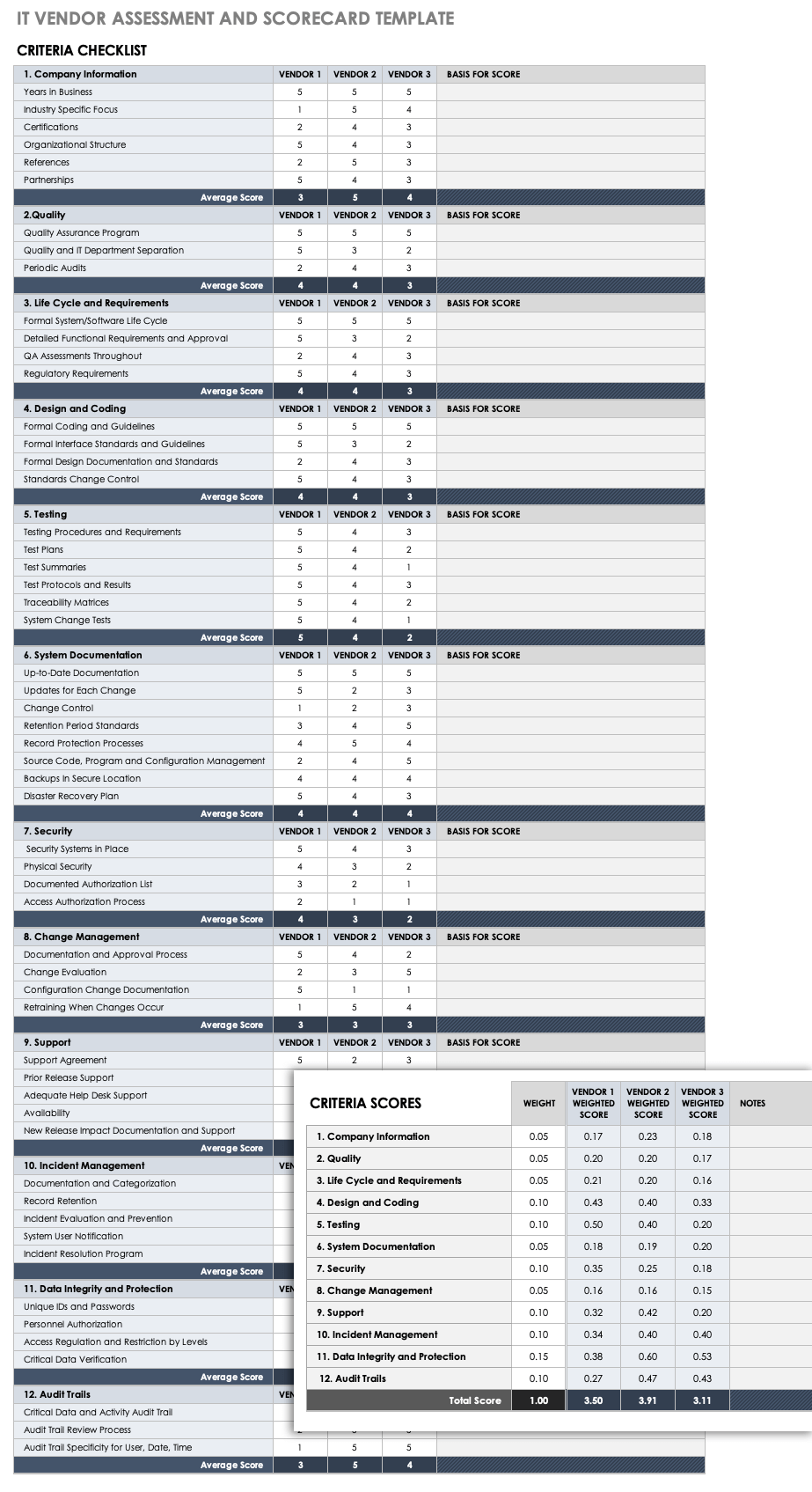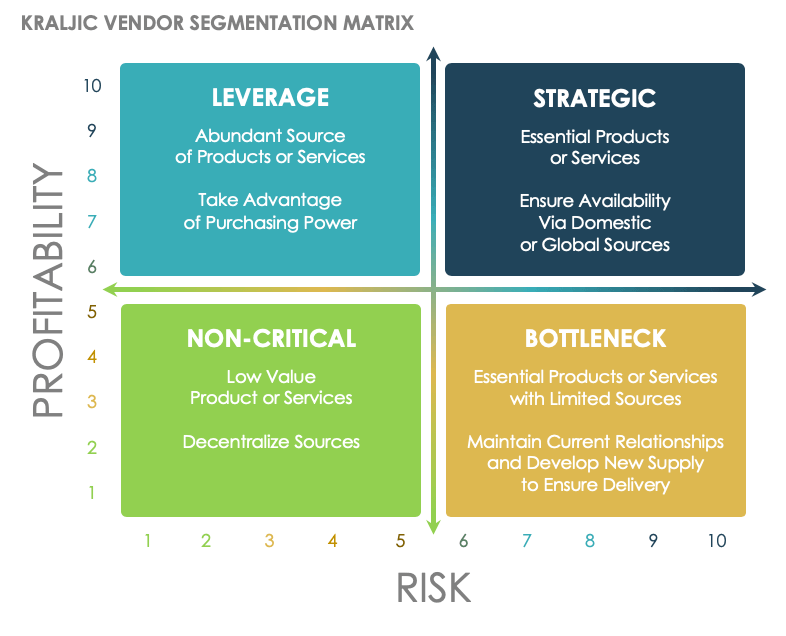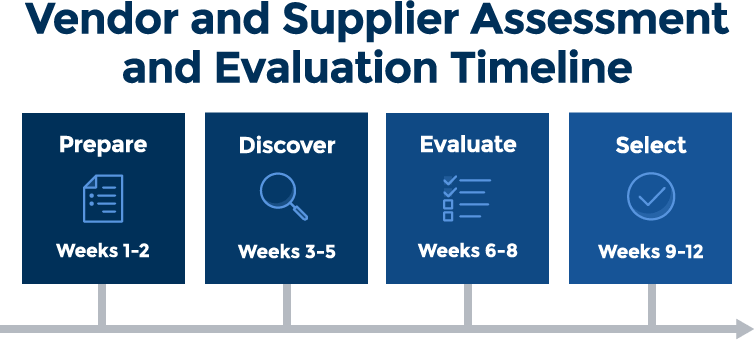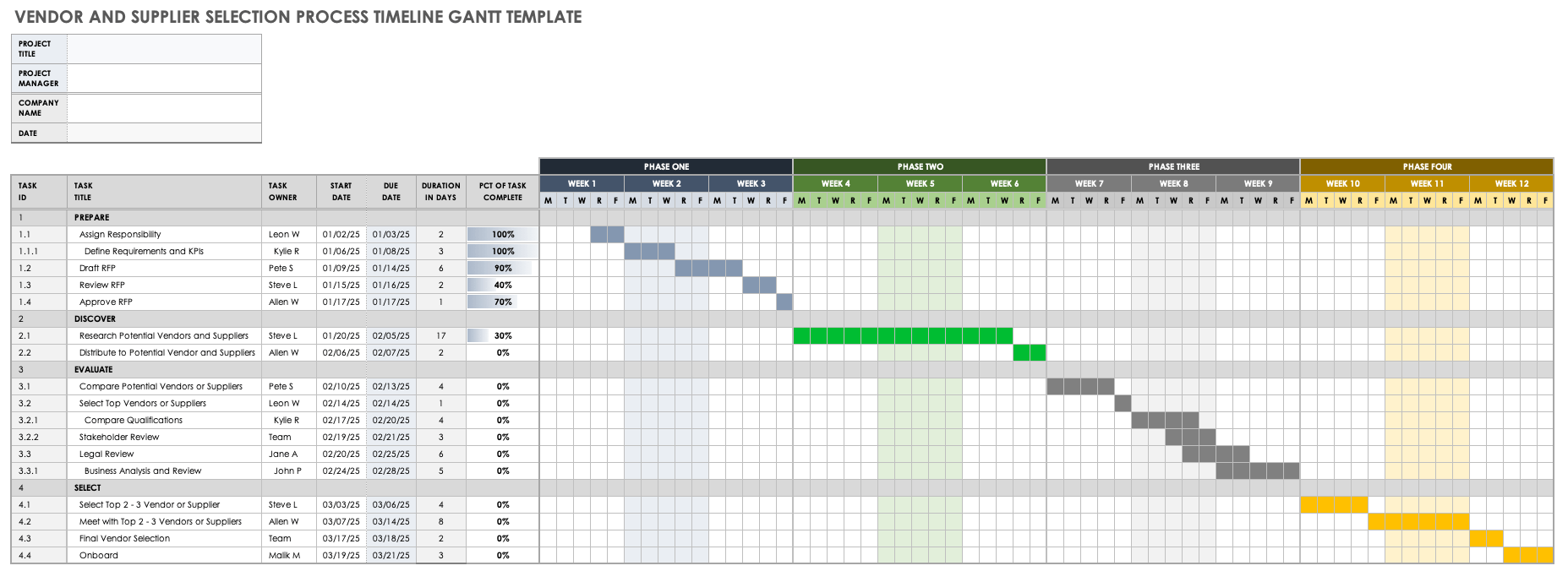What Is Vendor Assessment?
Vendor assessment is an evaluation and approval process that businesses can use to determine if prospective vendors and suppliers can meet their organizational standards and obligations once under contract. The end goal is to secure a low-risk, best-in-class vendor and supplier portfolio.
Vendors and suppliers both furnish services or goods, but there is a distinction: The term vendor applies to business-to-business (B2B) and business-to-consumer (B2C) sales relationships, while supplier applies only to B2B relationships.
Benefits of Vendor Assessment
Although the vendor assessment process can be challenging, the benefits include finding low-risk sources for high-quality goods and services, as well as the development of mutually beneficial, long-term business relationships.
Dr. Ray Carter is Director of DPSS Consultants (Developing People Serving the Supply Chain), creator of the 10C Model of Supplier Evaluation, and author of five vendor management and supply chain books, including Practical Procurement. Carter points to the COVID-19 pandemic as a prime example of the need for systematic vendor and supplier assessment that enables organizations to weather any storm in the business environment.
“What the COVID-19 emergency illustrates,” Carter says, “is the importance of engaging suppliers with sufficient resources and access to working capital to continue to operate, gear up if necessary to meet demand, and survive crises.” Assessing vendor and supplier crisis management plans is one of the aspects of risk mitigation you should consider during your vetting process. “Future crises driven by foreseeable factors — global warming, wild animal and nature conservation, human interactions, and political unrest — are almost inevitable. Therefore, exploring the quality and robustness of vendor and supplier contingency plans is crucial.”
Dr. Carter advises caution when selecting business partners for goods and services. “Deficient evaluation constructs begin with poorly defined specifications, which then feeds into the procurement process and award criteria and the selection of suppliers that lack the necessary expertise or resources,” Carter explains. “Post-award, this leads to a perfect storm: a fractious relationship characterized by ‘blame game’ disputes and, often, operational failure. A reliable process and careful vetting helps avoid that risk — and many others.”
Additional benefits of vendor assessment include the following:
- Risk Mitigation: By carefully vetting vendors and suppliers, you can lower the regulatory, contract, and security risks of working with entities outside your company.
- Lower Regulatory Compliance Risk: Confirm compliance with the laws, regulations, and standards that apply to your business. If your vendor is in another country or you sell to another country, check those countries’ legal requirements, too. For example, if you do business in the European Union, the General Data Protection Regulation (GDPR) applies.
- Scope of Service and Contract Compliance: Conduct a legal review of contract terms, nondisclosure agreements (NDAs), or partnership agreements to ensure that you’ve set favorable conditions and mitigated any risks.
- Decrease Security and Cyber Risk: The threat of cyber risk grows as we increasingly move our work to the cloud. Therefore, it’s crucial to protect all your customer and company data. Your selection process should focus on assessing a third-party vendor or supplier to store your data. First, identify and evaluate the type of data that vendors and suppliers may need to access, and decide whether they need to access all, some, or none of it to do their work. It’s crucial to ensure the vendor takes the proper measures to encrypt and protect your data. Once you identify potential partners, have them complete a questionnaire that thoroughly covers security management system details.
Get more risk mitigation information, tools, and templates in the “Definitive Guide to Vendor Risk Management.”
See how Smartsheet can help you be more effective
Watch the demo to see how you can more effectively manage your team, projects, and processes with real-time work management in Smartsheet.
Risk Assessment Matrix Template
Understand your organization’s tolerance for specific risks — this is an important factor when deciding which companies to contract companies for goods and services. This matrix captures the risk assessment information your company needs to review, estimate, and prioritize using rankings of generally acceptable (GA), as low as reasonably possible (ALARTP), and generally unacceptable (GU). Using this template, you can list each risk and determine their likelihood and rate the severity, all on a single color-coded chart.
Download the Risk Assessment Matrix Template
Excel | Word | PDF | Smartsheet
Find more useful tips and templates at “Free Vendor Risk Assessment Templates."
- Identify Top Vendors: Based on a considered combination of your essential vendor selection criteria and risk assessment, you’ll find vendors with the reputation, skills, and knowledge to solve your business challenges.
- Reduce Costs: While cost shouldn’t be the ultimate deciding factor, you will likely save by comparing top-notch vendors and the competitive environment by avoiding financial issues around poor service and delivery. Plus, once you establish your relationship, vendors may offer future opportunities to reduce costs through volume or continuity discounts further.
- Increase Efficiency: The ability of a business to act fast and move quickly depends on the smooth flow of your supply chain. With ongoing monitoring, you’ll notice when inefficiencies occur and be able to rectify them in partnership with your vendor or supplier before it’s too late.
- Strengthen Relationships: Proper vendor management, which fosters communication, collaboration, and loyalty, bolsters your brand and supports mutually beneficial working relationships that serve everyone in the long run and improve your reputation.
- Improve Your Business: Proper vetting will help you engage top-notice vendors and enable you to provide higher-quality and more competitively priced goods or services. This results in serving your customers far better — as you improve decision-making and effectiveness, expect an upswing in customer loyalty and sales.
By performing extensive due diligence before you engage a vendor or supplier, you can save time and money, as well as support trust and your company's reputation. Base that due diligence on criteria that make sense for you and your organization. For example, if data and personal information security is of utmost importance because you are a healthcare company bound by HIPAA security rules, that criteria may override cost or efficiency concerns.
Supplier and Vendor Assessment Framework
A vendor or supplier assessment framework supports an organized approach to vet and rank potential vendors. The framework is based on a set of standard criteria to determine prospective vendors’ suitability and any risks they may pose to your company.
You can use an assessment framework to determine the best vendor or supplier based not only on price, but also on a full spectrum of concerns that Dr. Carter of DPSS Consultants delineates in his 10C Model of Supplier Evaluation.
Dr. Carter created his model because he saw that poor supplier selection causes business breakdowns. “I developed my framework to provide a simple and systematic process of investigating, analyzing, and verifying the resources and capabilities of potential suppliers (the extent of which is dependent upon the risk and value of the contract) leading to the appointment of an effective and sustainable source.”
Vendor and supplier assessment occurs most often within purchasing departments. It also forms part of the pre-qualification step within the purchasing area, although it usually includes the participation and input of other departments and stakeholders.
The 10C Model of Supplier Evaluation allows sufficient space for you to fill in the blanks with criteria in each category that applies to your specific business, business model, and goods and services needs.
- Competency: Ask vendors to provide evidence of proven quality with other customers, and review their training and development procedures, qualification records, essential personnel background and abilities, and recruitment methods.
- Capacity: Look into prospective partners’ current and forecasted orders and customers, along with how that impacts the ability to meet your current and projected requirements. Ask for operational statistics around quality- or service-level challenges, which should be readily available if the supplier is ISO 9000 accredited. To learn more about this accreditation read “The Ultimate Guide to ISO 9000.”
- Commitment to Quality: Review the policies and procedures the company uses on an ongoing basis to monitor and manage quality and adherence to industry standards, such as ISO 9000 and HIPAA.
- Consistency of Performance: Ensure that your future partner will be able to deliver consistently high levels of quality and service throughout the life of the contract. For example, look for a vendor that assigns an account manager as a single point of contact dedicated to quality control and oversight; this indicates the vendor’s commitment to high performance.
- Cost: Review whether the product or service can be delivered at a reasonable price and keep your vendor or supplier in business.
- Cash and Finance: Of course, you want to work with a financially stable entity. Request the most recent fixed and current asset lists, profit and loss (P&L) statements, and credit rating documentation.
- Communication: Ensure that your vendor or supplier will set up and manage (or conform to your existing) communications channels, whether in person with your account manager and other key personnel, via virtual meetings, or with collaboration software.
- Control of Internal Processes: Ask for evidence of how the company manages inventory, quality control operations procurement, marketing, distribution and health, and safety.
- Clear (Corporate Social Responsibility): Vendor and supplier services and products should conform to legal and environmental standards and requirements.
- Culture: Determine if you and your potential partner share values and working philosophies before you enter into a contract. A similar outlook makes for smoother work relationships and helps you establish long-term partnerships.
Vendor Assessment Criteria
Vendor assessment criteria should support your company mission, ethics, and business goals in the areas of technical competence and quality, cost and financial integrity, ability to communicate, social responsibility, and cultural commitments.
Assessing vendors and suppliers also involves reviewing the criteria that matter most to your company goals and your larger industry. For example, if a business looks for a packaging company, the most significant concerns might involve graphics and structural design and rely on a review of custom versus standard options and shipping durability. Use the following checklist, based on the 10C Model of Supplier Evaluation, to gather your criteria on vendors and suppliers, and then use it as a “go or no go” tool to assess prospective or current business partners.
Vendor and Supplier Assessment Criteria Checklist
Download Vendor and Supplier Assessment Criteria Checklist
You can apply these criteria to potential partners, as well as use them to evaluate and rate current partners. Paring down partnerships is not a bad idea: according to research conducted in 2020 by The Hackett Group, companies average 3,000 suppliers per $1 billion in spend. While you may not spend $1 billion a year with your vendors and suppliers, if you don’t have strict control over your business partners or which companies have access to your data, you’re taking a risk from a financial and security standpoint.
How to Evaluate a Vendor
When evaluating vendors and suppliers, you’ll need to make both quantitative and qualitative assessments to ensure a purchasing process that works for your organization. It's a good idea to track metrics on an ongoing basis to confirm contracts are still beneficial.
Vendor Evaluation Template
This third-party vendor assessment template includes areas to note corrective actions and observations, but you can also adjust it to reflect your company criteria. Additionally, the template includes a scoring system that makes it easy to rank individual vendors and suppliers, and you can use the aggregated scores to make comparisons. By compiling this information in one place, you can combine written descriptions with ease.
Download Vendor Evaluation Template
If you need more templates to manage your supply chain process, take a look at “13 Free Vendor Templates.”
Different Methods of Vendor Evaluation
There is no single vendor evaluation method that covers every circumstance. To evaluate vendors, take into consideration your business and the vendor classification, as well as whether the vendor is a prospect or already under contract, and if you're conducting a post-award review.
Following is a list of common methods that you may use to conduct your vendor evaluation:
- Commercial: When considering the commercial side of any potential vendor or supplier, keep in mind their reputation, market dominance, market and advertising presence, awards, ability to deliver promptly, and existing clients.
- Technical: A technical evaluation is centered on standards for compliance, innovation, technical equipment, and scientific capabilities.
- Records: In this type of vendor evaluation, you collect data from public sources, such as financial records, industry news items, and award notices.
- Before-the-Fact: In this type of evaluation, the evaluator plans and starts gathering data from public data sources and vendor or supplier endorsement or reviews early in the history of the project. Replies to RFIs and RFPs with substantiating documents should provide many of the necessary answers, too.
- After-the-Fact: For this evaluation, review a first engagement or shipment and assess performance and process. Ask critical stakeholders about successes, failures, and operations. Responses provide data for decisions, future planning, and discussions after an event is complete.
By performing these vendor analysis methods based on criteria and data, you will have support in making evidence-based decisions. Remember that in today’s competitive business environment, you shouldn’t simply be solving for cost — the price for poor quality or delivery can be too high in the end.
Vendor Performance Evaluation
Vendor performance evaluation requires three elements: a vendor roster based on value to your organization; a system to track performance against metrics and service level agreement; and the utilization of a strategic ranking system.
1. Organize Your Roster: You can use the description of the goods or services a vendor supplies or rank them by their usefulness to the organization, then incorporate colors, numbers, letters, or words to categorize them in charts or spreadsheets. You can think about vendors by their value to the organization and how much you invest in their engagement to assign relative value by size, capability, or dollar amounts.
Use this scorecard as a selection or ongoing rating system template for your vendor roster. Once you've gathered your data and compiled it into the spreadsheet, you can use the roster to compare current vendors or to evaluate a single supplier. Easily edit the criteria checklist to match your business needs.
Download Vendor Assessment and Scorecard Template - Excel
To learn more about vendor management scorecards, refer to “The Ultimate to Vendor Scorecards.”
2. Establish Tracking and Performance: Pick an auditor or a small team that can promote or demote a vendor or highlight distinctive evaluations. Track vendor and supplier value on an ongoing basis, or take a survey based on trigger metrics that have raised concerns like quality issues, delivery delays, or damaged products.
Surveys can be helpful and provide a way to get input from purchasing or other personnel who may be closer to the situation than a manager. Set guidelines for employee feedback: Make sure they are fact-based and not just opinions. Answers to survey questions can be on a simple value scale from one to five. Survey categories and questions might include the following:
- Performance: Did the supplier perform according to specifications?
- Delivery: Were deliveries on time?
- Invoicing: How did the final price compare to the budget?
- Customer Service: How well does the vendor respond to questions or solve problems?
- Knowledge: How knowledgeable is the vendor about your company?
3. Maintain a Strategic Vendor Evaluation System: Apply what you know about vendor and supplier performance to segment vendors strategically. The Kraljic Matrix is a vendor evaluation method used to apportion goods or services by dividing them into four quadrants or classes, based on the risk or complexity of market supply and the value of the purchased item based on the impact to your company’s profitability. The matrix allows your company to define the most advantageous purchasing strategies and avoid bottlenecks that prevent you from meeting your product or service delivery goals.
Kraljic Vendor Segmentation Matrix Template
Use this template to maximize supply stability, lower costs, and shift procurement from a transaction to a strategic activity. In the Kraljic model, supply risk rises when there are few suppliers; when availability could be affected by natural disasters, pandemics, or government instability; or when delivery logistics are challenging. Profit impact is high when the item adds sizable value to the organization's productivity or impacts quality.
The template prompts you to classify services and products you purchase as strategic, leverage, bottleneck, or non-critical, according to the supply risk and profit potential of each. Doing so helps you determine which vendors make the most sense based on business objectives.
Download Kraljic Vendor Segmentation Matrix Template
Perform ongoing vendor reviews to yield red flags when vendors don't meet expectations. The process should be easy if you have proper documentation and ongoing oversight. When problems occur, alert the vendor right away. You and the vendor should have contingency plans for potential workarounds when issues arise. If it looks like there's no remedy and the situation isn't an anomaly, you may need to end the partnership. If you terminate a relationship, be sure to have a post-mortem with your team and vendor.
Tips to Improve the Vendor Assessment Process
The vendor assessment process centers on clarity and a time-based, four-phase approach: prepare (lay the groundwork); discover (perform due diligence); evaluate (perform a vendor comparison); and select (make decisions and sign contracts). Below are two key best practices to keep in mind when assessing vendors:
- Assign Responsibility: Decide who in your company is responsible for the assessment. It’s often an employee in the purchasing department, but for high-dollar or complex situations, you may hire an outside business analyst. The consultant takes over some of the time-consuming aspects of the process, including research, writing the request for proposal (RFP), and performing an in-depth financial analysis that may not be available in house.
- Set Up a Timeframe: Without a timeframe and process, getting to the final selection and hiring process can take up to a year. A good rule of thumb is to allow a maximum of three months to complete the process.
Vendor and Supplier Selection Process and Timeline
1. Prepare: This is the state when you define your basic requirements and create request-for-information (RFI) and request-for-proposal (RFP) packages. RFIs and RFPs provide a standard against which to evaluate potential vendors. They provide a detailed explanation of what you want and why, and you can use them to solicit bids and identify the best partner in developing the product. An RFI or RFP is a competitive process in which several companies may submit proposals. If you’re new to the RFI and RFP process, read “Write a Winning Request for Proposal and Conquer the Process in Your Company.”
2. Discover: Research vendors and suppliers, and distribute RFIs and RFPs to companies that meet your criteria.
3. Evaluate: Evaluate RFI and RFP responses. Select the top vendors, compare their qualifications, and review with stakeholders, legal, and business analysts.
After you’ve received RFIs or RFPs from potential vendors or suppliers, use this spreadsheet to quickly compare them based on criteria or business attributes in your screening documents. This template provides a simple way to compile statistics and background information to aid in your selection process.
Download Vendor Comparison Template
4. Select: Based on criteria you set, choose and meet with the top two potential vendors. Have the purchasing lead or key decision-makers make a final selection. Prepare contracts, set up accounts, and prepare for onboarding.
Vendor and Supplier Selection Process and Timeline Gantt Template
This Gantt template provides all team members with a simple way to organize and track the vendor and selection process, as well as ensure that you’re sticking to deadlines. To begin your selection process, input the task data — organized here into the Prepare, Discover, Evaluate, and Select phases — along with who owns the task, as well as start and end dates, to generate a high-level visual overview. Customize and add more steps as your organization requires them.
Download the Vendor and Supplier Selection Process and Timeline Gantt Template
- Verify Information by Quality: When you evaluate vendors and suppliers, obtain the best possible information. “A key aspect of the 10C Model is the need to assess the quality and validity of the information submitted by potential partner companies,” advises Dr. Carter.
“The model defines verified and high-quality evidence as complete, verified by a third party, current and comprehensive. Medium-quality evidence is almost complete, offers some verification, some observation, and a contribution of desk research and limited observation. Low-quality evidence relies on records and desk research, is incomplete, and has limited verification. You can use these scores in the overall evaluation of the contractor or supplier,” says Dr. Carter. - Establish Key Performance Indicators (KPIs): KPIs are business metrics deployed to evaluate the performance of specific factors and strategic goals that are crucial to company success. You can use KPIs in vendor evaluation to help vet their performance. Find out more about developing your own KPIs and how to organize them with “All About KPI Dashboards.”
- Consider a Common Playbook: If you’re working with other vendors on a large project, Dr. Carter says a common pre-qualification process makes sense. “The principal contractors working on HS2 (UK’s £100M proposed high-speed rail link) have collaborated to create a common pre-qualification system that will cut costs and streamline tenders for subcontractors,” he explains. “Bidders who want to work with four of the main contractors on the HS2 scheme will go through an identical pre-qualification process, thus reducing duplication and the constant reworking of submission information to meet the varied formats of the customer.”
- Emphasize Communications: Give and take to improve relationships and deliverables. Be clear with vendors early in any process or project about expectations, deadlines, and critical information without overwhelming them. Personalize communication and respond promptly to concerns.
- Make a Site Visit: Conduct a site visit to verify that information submitted in writing or through conversation reflects reality. An in-person inspection reveals how the supplier conducts business, as well as their capacity to meet your criteria.
- Onboard: Once you’ve gone through such an exacting process, you’ll want to maintain good relationships with your vendors. A proven way to start on the right foot and ensure a smooth interaction is with a transparent process to bring your new suppliers online. Learn onboarding best practices with “How to Streamline Supplier and Vendor Onboarding: Best Practices, Process Flows, and Checklists.”
Leverage Cloud-Based Software: Use cloud-based software to simplify compliance, reduce risk, and help organize and speed vendor assessments.
Disaster and Pandemic Readiness
Assessing vendors should include questions about disaster and pandemic preparedness. The COVID-19 pandemic has underscored the need to assess vendors’ ability to deliver the services and products you need to maintain critical operations under emergency conditions.
Diversity of customer, supplier, and third-party providers across geographies will help avoid single points of failure and decrease your organization's exposure to local outages, as well as geopolitical and pandemic events.
Here are some disaster and pandemic readiness questions to ask of present and potential vendors:
Build Powerful, Automated Business Processes and Workflows with Smartsheet
Empower your people to go above and beyond with a flexible platform designed to match the needs of your team — and adapt as those needs change.
The Smartsheet platform makes it easy to plan, capture, manage, and report on work from anywhere, helping your team be more effective and get more done. Report on key metrics and get real-time visibility into work as it happens with roll-up reports, dashboards, and automated workflows built to keep your team connected and informed.
When teams have clarity into the work getting done, there’s no telling how much more they can accomplish in the same amount of time. Try Smartsheet for free, today.

